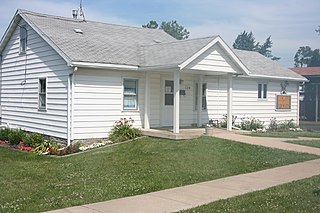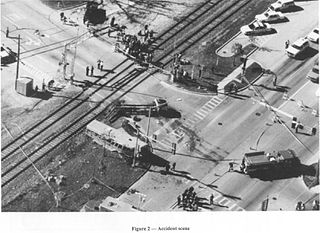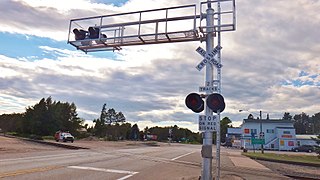
A roundabout, a rotary and a traffic circle are types of circular intersection or junction in which road traffic is permitted to flow in one direction around a central island, and priority is typically given to traffic already in the junction.

An intersection or an at-grade junction is a junction where two or more roads converge, diverge, meet or cross at the same height, as opposed to an interchange, which uses bridges or tunnels to separate different roads. Major intersections are often delineated by gores and may be classified by road segments, traffic controls and lane design.

A level crossing is an intersection where a railway line crosses a road, path, or airport runway, at the same level, as opposed to the railway line crossing over or under using an overpass or tunnel. The term also applies when a light rail line with separate right-of-way or reserved track crosses a road in the same fashion. Other names include railway level crossing, railway crossing, grade crossing or railroad crossing, road through railroad, criss-cross, train crossing, and RXR (abbreviated).

Wigwag is a nickname for a type of railroad grade crossing signal once common in North America, referring to its pendulum-like motion that signaled a train's approach. The device is generally credited to Albert Hunt, a mechanical engineer at Southern California's Pacific Electric (PE) interurban streetcar railroad, who invented it in 1909 for safer railroad grade crossings. The term should not be confused with its usage in Britain, where "wigwag" generally refers to alternate flashing lights, such as those found at modern level crossings.

The Rochelle Railroad Park is a city park located in Rochelle, Illinois where railfans can safely view and photograph trains.

In railway signalling, an interlocking is an arrangement of signal apparatus that prevents conflicting movements through an arrangement of tracks such as junctions or crossings. In North America, a set of signalling appliances and tracks interlocked together are sometimes collectively referred to as an interlocking plant or just as an interlocking. An interlocking system is designed so that it is impossible to display a signal to proceed unless the route to be used is proven safe.

A partial cloverleaf interchange or parclo is a modification of a cloverleaf interchange.

On March 15, 1999, Amtrak's southbound City of New Orleans passenger train collided with a semi-trailer truck in the village of Bourbonnais, Illinois, United States. Most of the train derailed, killing eleven people. A National Transportation Safety Board (NTSB) investigation into the accident attributed the cause to the truck driver trying to beat the train across a grade crossing. The NTSB's recommendations from the accident included increased enforcement of grade crossing signals, the installation of train event recorders at all new or improved grade crossings, and procedures to provide emergency responders with accurate lists of all crew members and passengers aboard trains. The city of Bourbonnais erected a memorial near the site to commemorate those killed in the accident.

A crossbuck is a traffic sign used to indicate a level railway crossing. It is composed of two slats of wood or metal of equal length, fastened together on a pole in a saltire formation. Crossbucks are often supplemented by electrical warnings of flashing lights, a bell, and/or a boom barrier that descends to block the road and prevent traffic from crossing the tracks.

The 1995 Fox River Grove bus–train collision was a grade crossing collision that killed seven students riding aboard a school bus in Fox River Grove, Illinois, on the morning of October 25, 1995. The school bus, driven by a substitute driver, was stopped at a traffic light with the rearmost portion extending onto a portion of the railroad tracks when it was struck by a Metra Union Pacific Northwest Line train, train 624 en route to Chicago.
Australian railway signalling varies between the States of Australia, because the individual States are responsible for the railway systems within their own borders, with, historically, no need to co-ordinate between states except at the boundaries.

A junction is where two or more roads meet.

The HaBonim disaster was an accident which took place on June 11, 1985, when an Israel Railways train collided with a bus carrying schoolchildren on a field trip from Y.H. Brenner middle school in Petah Tikva, Israel. The crash happened near Moshav HaBonim, killing 22 people, and injuring 17.

Level crossing signals are the electronic warning devices for road vehicles at railroad level crossings.

On the evening of February 3, 2015, a commuter train on Metro-North Railroad's Harlem Line struck a passenger car at a grade crossing near Valhalla, New York, United States, between the Valhalla and Mount Pleasant stations, killing six people and injuring 15 others, seven very seriously. The crash is the deadliest in Metro-North's history, and at the time the deadliest rail accident in the United States since the June 2009 Washington Metro train collision, which killed nine passengers and injured 80.

Terminology related to road transport—the transport of passengers or goods on paved routes between places—is diverse, with variation between dialects of English. There may also be regional differences within a single country, and some terms differ based on the side of the road traffic drives on. This glossary is an alphabetical listing of road transport terms.

Bosnia and Herzegovina is a signatory to the Vienna Convention on Road Signs and Signals. Therefore, road signs do not differ much from the rest of Europe, such as Croatia, Slovenia, Serbia and North Macedonia. Ministry of Transportation of Bosnia and Herzegovina regulates them. Bosnia and Herzegovina drives on the right as with the rest of Europe, except for Cyprus, Ireland, Malta and the United Kingdom. Bosnian and Herzegovinan road signs have two scripts, Latin and Cyrillic script.

There are around 6,000 level crossings in the United Kingdom, of which about 1,500 are public highway crossings. This number is gradually being reduced as the risk of accidents at level crossings is considered high. The director of the UK Railway Inspectorate commented in 2004 that "the use of level crossings contributes the greatest potential for catastrophic risk on the railways." The creation of new level crossings on the national network is banned, with bridges and tunnels being the more favoured options. The cost of making significant reductions, other than by simply closing the crossings, is substantial; some commentators argue that the money could be better spent. Some 5,000 crossings are user-worked crossings or footpaths with very low usage. The removal of crossings can improve train performance and lower accident rates, as some crossings have low rail speed limits enforced on them to protect road users. In fact, between 1845 and 1933, there was a 4 miles per hour (6.4 km/h) speed limit on level crossings of turnpike roads adjacent to stations for lines whose authorising act of Parliament had been consolidated in the Railways Clauses Consolidation Act 1845 although this limit was at least sometimes disregarded.

The E-signal is a type of level crossing signals used in Sweden on very low-traffic roads crossing a railroad track, when the same landowner owns the property on both sides of the railway track and only a few residential buildings and no facility of public interest can be reached from the road. An e-signal operates in the opposite fashion of a conventional grade crossing signal: it is lit when no train is approaching the crossing, and when a train approaches, it extinguishes approximately 30-60 seconds before the train's arrival. This is intended to provide a 'fail safe' function, in the event the power has failed or the signal bulb has blown; e-signal mountings are always supplemented with an information plate indicating the function of the signal. It is supplied from the track circuit which supply a voltage to one rail in order to detect trains. When there is a train there can be no voltage difference between the rails. This means that no external uninterruptible power supply is needed and the installation cost is greatly reduced, allowing many more to be installed within limited budgets.
Designs of level crossings, where railway lines cross roads or other paths, vary country-to-country.


















